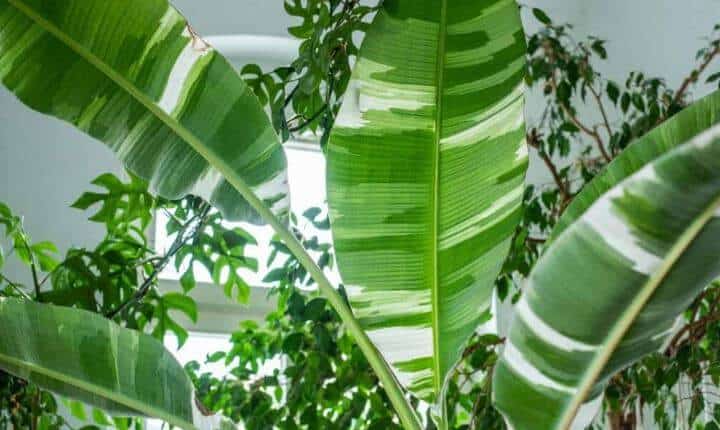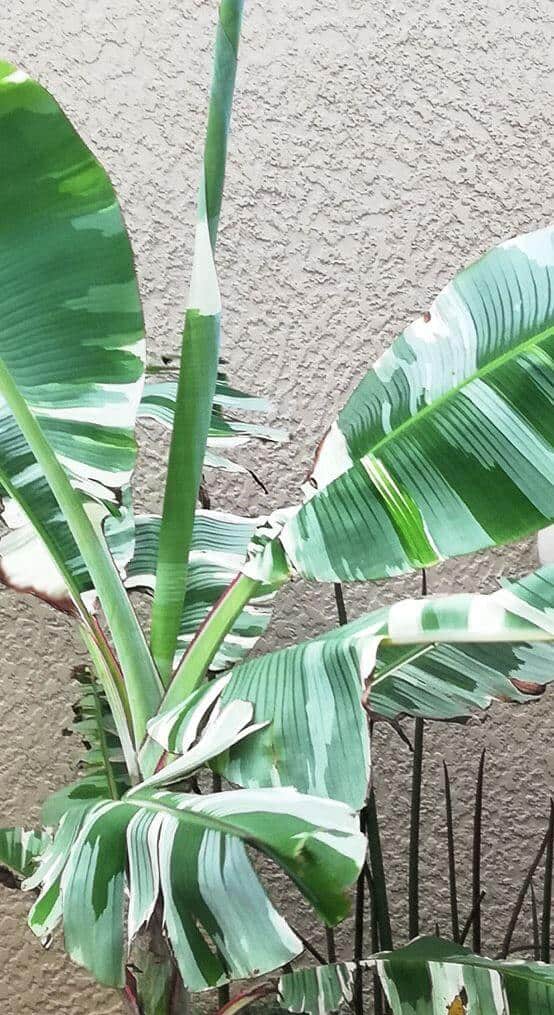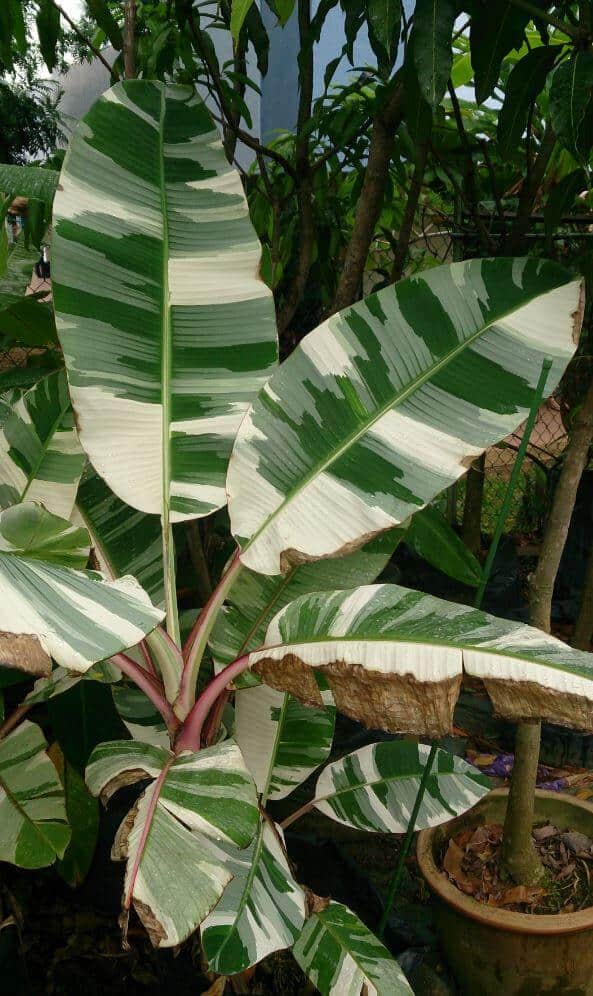Last Updated on January 5, 2023 by a Friendly Gardener
There are over 1,000 varieties of banana trees, but one of the rarer types is the variegated banana tree, where the leaves, as well as the fruits, have colored stripes or splotches of pale green or white.
Although they are referred to as banana trees, variegated banana plants are herbaceous plants i.e., they don’t have woody stems.
Variegated banana plants are often grown as indoor plants and not to produce fruits. But if the environment is right, the plant can bear fruits too, which are edible.
In this article, we’ll discuss in-depth all about the variegated banana plant and its care.
Characteristics of the Variegated Banana Tree

The variegated banana tree is native to Southeast Asia, near Indonesia, Malaysia and Philippines, and the South Pacific Islands.
They then found their way to other places like the Hawaiian Islands, Florida, and other tropical regions. In Hawaii, the variegated banana tree became quite popular and was called ‘Musa ae ae.’
The variegated banana tree is originally from the regular banana tree and so looks quite similar with its trunk rising upward and soft, wide variegated white and green leaves hanging from the branches.
A mature variegated banana tree grows to a height of up to 9 to 15 feet. The tree grows an underground stem called a corm or rhizome, and it produces a lateral shoot known as the sucker.
These suckers develop into new banana plants. The main trunk of the banana plant is called the pseudostem. In summer and spring, the plant may bear pink or red flowers with winding petals.
If you want the variegated banana tree to bear flowers, then you must ensure that it has proper growing conditions i.e., high temperatures and lots of light. The plant may bear fruit after 3-4 years.
When they are ripe, the fruits turn light yellow and usually have a sweet taste. The bananas borne by the variegated banana tree are also usually variegated and retain their light-colored stripes but lose the green stripes when they ripen.
Variegated bananas can be eaten both in raw as well as cooked forms and can be used in casseroles, stews, stir-fries, soups, and salad dressings.
Variegated Banana Plant Care
The variegated banana plant can be grown both outdoors, as well as indoors. If you’re growing the variegated banana plant outdoors in your garden, then ensure that you plant it in a place that has good drainage.
Avoid planting it in any location that is too close to a water source, such as a stream, etc. When grown indoors, the variegated banana plant needs well-draining soil, regular watering, and ample sunlight.
Light
The variegated banana plant needs full sunlight, around 6 to 8 hours a day, but it can also grow well in partial shade conditions.
If you’re growing the plant indoors, then it is recommended to place it in a south-facing window. You can place the plant outdoors during the summer months.
Temperature and Humidity
Since they are tropical, the variegated banana plant thrives in high humidity and warm conditions, with temperatures between 68°F -85°F. The plant does not tolerate the cold and so it must be brought indoors before the temperatures begin falling.
When indoors, place the plant in a cool, dry, and well-aerated place. If you’re unable to find a cool and dry place, then place the plant near a door or window, which you can open and allow in the fresh air.
Maintain the humidity levels between 50% to 60%. When the weather is cold, you can mist water around the plants manually to increase the humidity.
Soil

The variegated banana plant needs a well-draining soil mix to thrive. To make the soil well-draining, you can mix some perlite, sand, and coco-coir and place some small and medium rocks on the soil. The plant does well in slightly acidic soil (5.5 to 6.5 pH).
Watering
The variegated banana plant needs plenty of water, as well as lots of moisture in the air, especially during the growing season. The plants thrive when planted together as it helps to hold the moisture in the leaves.
The plant should be watered regularly, once every few days. Avoid letting the soil dry out and do not let the water sit on the leaves of the plant. Make sure that the soil is wet but it should not be soggy.
Overwatering the variegated banana plant can cause root rot. Overwatering can also cause the leaves of the plant to turn yellow and may cause problems like moldy or heavy soil, softened stem, powdery mildew on the body, and death of the basal offset.
Fertilizing
For the good and healthy growth of the variegated banana plant, it must be fed regularly. It is recommended to feed the plant once in two weeks with balanced fertilization during its active growing season.
During the plant’s resting period, between fall to spring, just fertilizing once a month is sufficient. Mix compost in the soil every year to increase the organic compounds.
Repotting

Typically, variegated banana plants have a high growth rate and can reach the ceiling. The roots also tend to develop quickly.
So, if the roots do not have sufficient space to spread further, the plant may stop growing, which is a sign that it needs a larger pot. Repotting not only helps the variegated banana plant to grow well but also prevents root rot.
Pruning

You can prune the variegated banana plant to make it look neat. Many pseudostems grow from the plant when it is grown from the corm, but it is recommended to keep just one, as the plant can utilize all the energy and make this the main trunk.
It’s a good idea to cut the weaker pseudostems at the topsoil. After around 6 to 8 months, when you see suckers or small shoots growing from the pseudostem, retain one sucker and prune the rest. This will replace the main stem after the fruiting season.
Pests

The variegated banana plant is prone to pests like scales, aphids, and thrips. Remove them with a towel or tissue. But if the infestation is large, then you may need to use insecticidal soap or neem oil to get rid of them.
The plant may be also prone to nematode and black weevil attacks and if it is severe, then you may have to use insecticides to remove them.
Propagation
It is very easy to propagate the variegated banana plant. The plant can be propagated by division. All you need to do is take a healthy sucker (shoot) and plant it in a container or another place in the garden.
Wrapping Up

The variegated banana plant is hugely popular amongst plant enthusiasts, collectors, and hobbyists.
An eye-catching plant with its large, elegant foliage in white, green, and mint hues, which looks as if it’s been hand-painted and its variegated fruit, the variegated banana plant is a must-have in your plant collection and can enhance the tropical vibe in your home.


